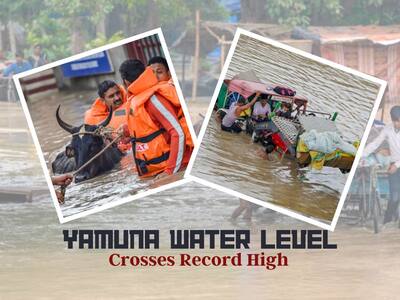
The overflowing Yamuna has flooded several areas in Delhi, putting the national capital on high alert.
Delhi has been placed on high alert after the Yamuna swamped many neighbourhoods. The Delhi Traffic Police warned the locals to stay off several important routes that have been submerged as the river reached record levels on Thursday.
Yamuna’s water level was 208.05 metres at 10 a.m. on Thursday, according to the Central Water Commission, which described the situation as ‘extreme’. Taking cognizance of the worsening situation in the national capital due to torrential rains and potential flooding, the officials informed that 10 schools, including 7 in Shahadra and low-lying portions of Delhi’s Civil Lines zone have been asked to remain closed until further order.
The Delhi police have also imposed section 144 CrPC as a precautionary measure in the flood-prone areas in Delhi.
Common Diseases To Watch Out For During Floods
Floods are one of the natural disasters which have a massive range of health impacts. Floods not only pose immediate risks, like drowning, but they also have the potential to spread more contagious diseases.
Typhoid Fever
Salmonella Typhi is the bacterium that causes typhoid fever. Once inside the body, the bacteria multiply and travel throughout the bloodstream, resulting in symptoms such as persistent fever, exhaustion, headache, nausea, abdominal pain, and either constipation or diarrhoea. If left untreated, typhoid illness can be fatal.
It is transmitted by consuming food or drinking water that has been tainted with an infected person’s faeces. Typhoid outbreaks can be more likely during floods if there is poor sanitation and hygiene.
Typhoid immunisations, drinking clean water, and maintaining proper sanitation and hygiene among food handlers are all excellent typhoid prevention measures. Regular hand washing also aids in disease prevention.
Malaria
Plasmodium parasites are the deadly infectious illness that causes malaria. Through the bites of infected female Anopheles mosquitoes, the parasites are transferred to humans.
READ RELATED: 9 Foods You Should Never Buy at Trader Joe's, According to Customers
Frequent signs of malaria include fever, exhaustion, nausea, and headaches. In extreme circumstances, it may result in coma, seizures, yellow skin, or even death.
Dengue Fever
The dengue virus is a mosquito-transmitted viral infection that can produce severe flu-like disease and, in rare cases, a potentially fatal complication known as severe dengue. The virus is often transmitted through the bite of an Aedes aegypti mosquito. Some of the common symptoms include – fever, body ache, muscle pain and cold.
Hypothermia
When the body loses heat more quickly than it can produce it, a medical emergency known as hypothermia (body temperature below 35 degrees Celsius) results. In times of flooding, hypothermia is more likely to affect children and the elderly. The symptoms associated with this condition highly depends on the severity of the condition.
Hepatitis A
Hepatovirus A (HAV) is the cause of the extremely contagious liver infection known as hepatitis A. Ingestion of water or food tainted with an infected person’s faeces or close contact with an infectious person are the two main ways that the virus is spread. Some of the common signs and symptoms of hepatitis A are — fever, malaise, lack of appetite, diarrhoea, nausea, abdominal pain, dark urine, and jaundice (yellowing of the skin and whites of the eyes).
Total Wellness is now just a click away.
Follow us on
Don’t Miss Out on the Latest Updates.
Subscribe to Our Newsletter Today!
window.addEventListener(‘load’, (event) => {
$(‘#commentbtn’).on(“click”,function(){
(function(d, s, id) { var js, fjs = d.getElementsByTagName(s)[0]; if (d.getElementById(id)) return; js = d.createElement(s); js.id = id; js.src = “//connect.facebook.net/en_US/sdk.js#xfbml=1&version=v2.3”; fjs.parentNode.insertBefore(js, fjs);}(document, ‘script’, ‘facebook-jssdk’));
$(“.cmntbox”).toggle();
});
});







